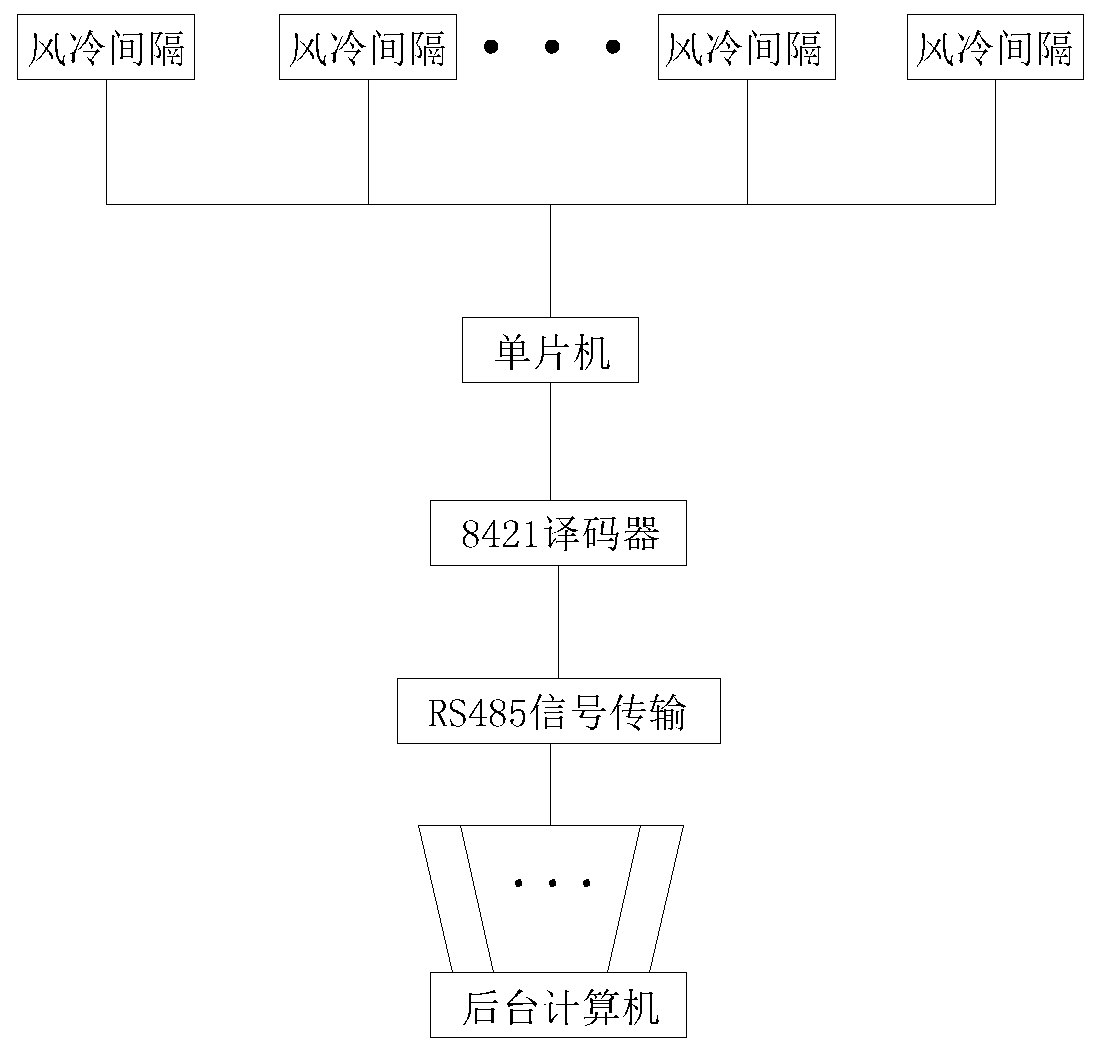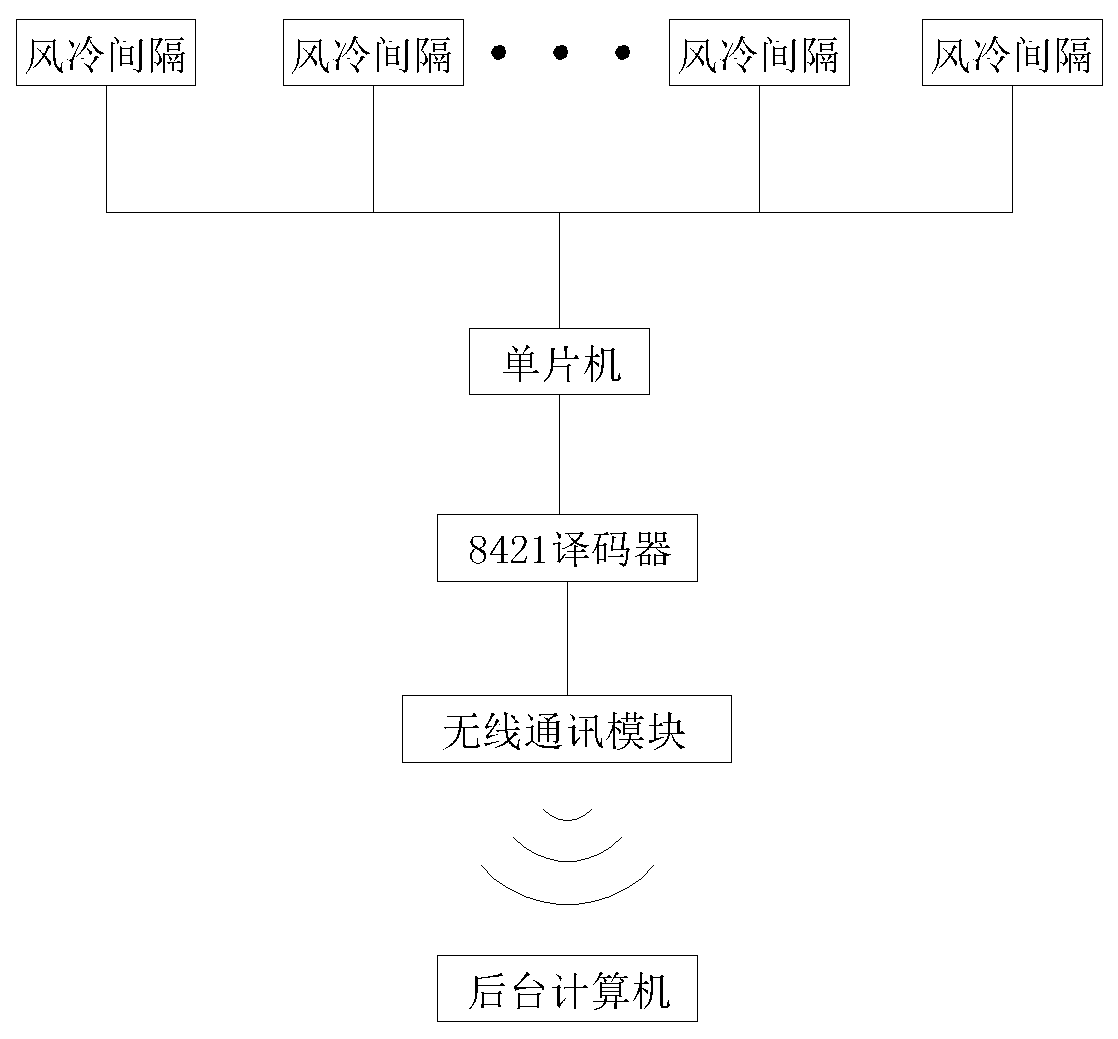Air cooling fault alarm device applied to substation transformers and working method thereof
A fault alarm and transformer technology, applied in the field of power transmission and transformation, can solve problems such as affecting the operating life of the main transformer, unfavorable maintenance work, and increasing the workload of maintenance personnel, shortening the time for preparing spare parts, arranging fault elimination time, and reasonable The effect of fault elimination time
- Summary
- Abstract
- Description
- Claims
- Application Information
AI Technical Summary
Problems solved by technology
Method used
Image
Examples
Embodiment 1
[0044] as attached figure 1 shown;
[0045] An air-cooling fault alarm device applied to transformers in substations, including an air-cooling interval corresponding to each group of fans, a single-chip computer connected to the air-cooling interval, and a background computer communicating with the single-chip computer;
[0046]The air-cooling compartments in each group are respectively connected to the signal input terminals of the single-chip microcomputer through wires, and the power failure of the fan unit in the air-cooling compartment is transmitted to the single-chip microcomputer through the wires.
[0047] Further, the signal output terminal of the single-chip microcomputer is connected to an 8421 decoder, and the state of the binary code output by the single-chip computer of the 8421 decoder is translated into an output signal to realize a decoding operation.
[0048] Decoding is the reverse process of encoding. During encoding, each binary code is endowed with a sp...
Embodiment 2
[0063] Such as figure 2 shown;
[0064] An air-cooling fault alarm device applied to transformers in substations, including an air-cooling interval corresponding to each group of fans, a single-chip computer connected to the air-cooling interval, and a background computer communicating with the single-chip computer;
[0065] The air-cooling compartments in each group are respectively connected to the signal input terminals of the single-chip microcomputer through wires, and the power failure of the fan unit in the air-cooling compartment is transmitted to the single-chip microcomputer through the wires.
[0066] Further, the signal output terminal of the single-chip microcomputer is connected to an 8421 decoder, and the state of the binary code output by the single-chip computer of the 8421 decoder is translated into an output signal to realize a decoding operation.
[0067] Further, the output terminal of the 8421 decoder is electrically connected to a wireless communicatio...
Embodiment 3
[0079] An air-cooling fault alarm device applied to transformers in substations, including an air-cooling interval corresponding to each group of fans, a single-chip computer connected to the air-cooling interval, and a background computer communicating with the single-chip computer;
[0080] The air-cooling compartments in each group are respectively connected to the signal input terminals of the single-chip microcomputer through wires, and the power failure of the fan unit in the air-cooling compartment is transmitted to the single-chip microcomputer through the wires.
[0081] Further, the signal output terminal of the single-chip microcomputer is connected to an 8421 decoder, and the state of the binary code output by the single-chip computer of the 8421 decoder is translated into an output signal to realize a decoding operation.
[0082] Decoding is the reverse process of encoding. During encoding, each binary code is endowed with a specific meaning, that is, it expresses ...
PUM
 Login to View More
Login to View More Abstract
Description
Claims
Application Information
 Login to View More
Login to View More - R&D
- Intellectual Property
- Life Sciences
- Materials
- Tech Scout
- Unparalleled Data Quality
- Higher Quality Content
- 60% Fewer Hallucinations
Browse by: Latest US Patents, China's latest patents, Technical Efficacy Thesaurus, Application Domain, Technology Topic, Popular Technical Reports.
© 2025 PatSnap. All rights reserved.Legal|Privacy policy|Modern Slavery Act Transparency Statement|Sitemap|About US| Contact US: help@patsnap.com


